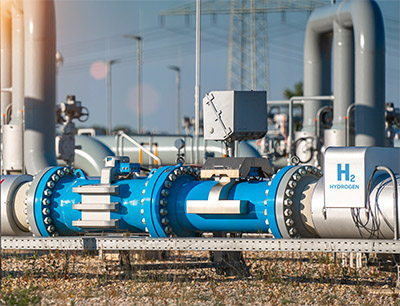
Japanese exploration and production company Inpex Corporation will use Hipact, a regenerative high-pressure CO2 capture technology jointly developed by BASF and its engineering partner JGC Corporation, as part of the "Kashiwazaki Clean Hydrogen/Ammonia" project. This is the first pilot project for the production of blue hydrogen and ammonia in Japan from locally produced natural gas.
The process enables the consistent implementation of carbon capture, utilization and storage (CCUS for short) in regional exploited gas fields and the use of hydrogen for power generation and ammonia production. The project is funded by the Japanese government's New Energy and Industrial Technology Development Organization (Nedo for short). Hipact technology is used to efficiently capture and recover carbon dioxide from the process gas of a hydrogen production plant. The feedstock is domestic natural gas. The production plant is located in the Hirai area of the city of Kashiwazaki, in Niigata Prefecture, Japan. It is being built by JGC Japan Corporation and is scheduled to be operational in 2025. The recovered CO2 will be injected into the reservoirs of the exploited gas fields, using CCUS technologies for enhanced gas recovery.
Due to Hipact's heat resistance and high CO2 capture efficiency, the technology is expected to reduce the cost of capturing and compressing CO2 by up to 35 percent compared to conventional technologies by releasing the CO2 off-gas above atmospheric pressure. Since carbon dioxide can be stored underground to save energy, maximum benefits are expected for Carbon Capture and Storage (CCS).
Mami Kawakatsu, Head of Sales in BASF Japan's Intermediates division, said, "Following the successful use of BASF's Oasis gas scrubbing technology in another Nedo-funded CCS project in Tomakomai, Japan, we are pleased to supply Hipact for Japan's first pilot project to produce blue hydrogen and ammonia from domestic natural gas. The role of our excellent gas processing technologies is recognized in these milestone projects in Japan's Net Zero roadmap. We will thus continue to contribute to Japan's goal of achieving carbon neutrality by 2050."
"The implementation of Hipact is the result of our excellent partnership with the JGC Group by combining our capabilities in process technology and plant engineering. We look forward to the use of Hipact in expanding global CCUS landscape," added Lawrence Loe, Director, Oase Gas Treating Excellence, Intermediates Asia Pacific.
Gas treatment technologies from BASF are already used in more than 500 reference plants worldwide. The company has more than 50 years of experience in this field. Under the Oase brand, BASF markets gas treatment technologies for a wide range of applications, including natural gas, syngas, flue gas and biogas. Hipact is a dedicated solution for the treatment of natural gas and syngas with CCS or CO2 enhanced oil/gas recovery. Hipact and Oase products contribute significantly to cost savings and sustainability in the value chain.